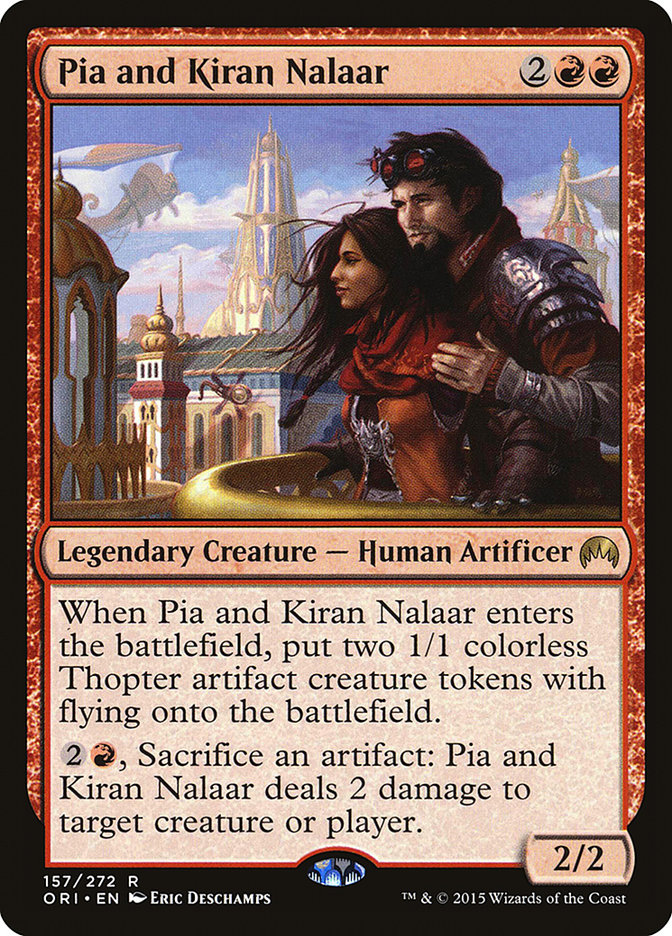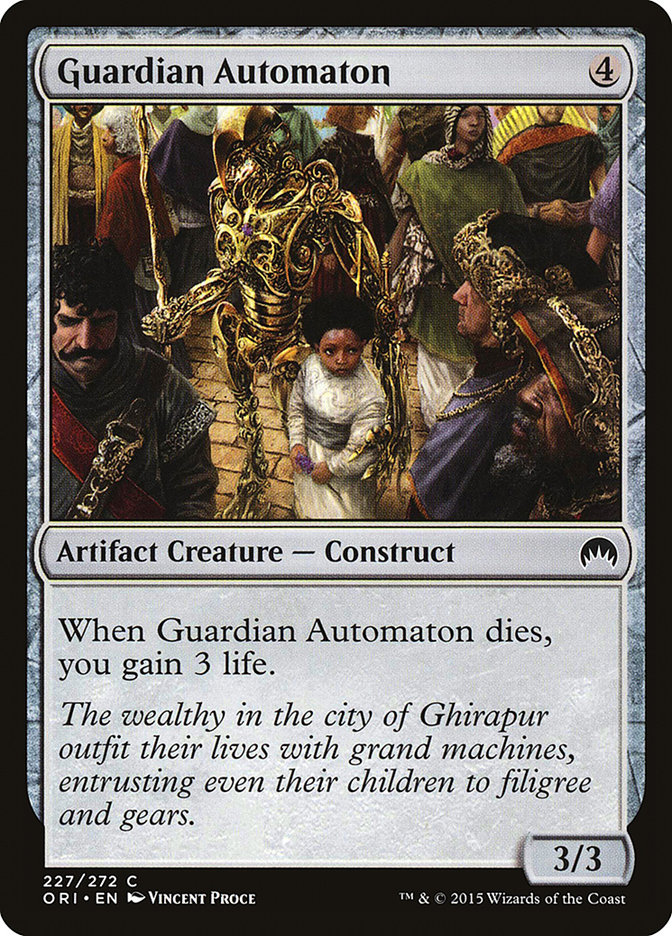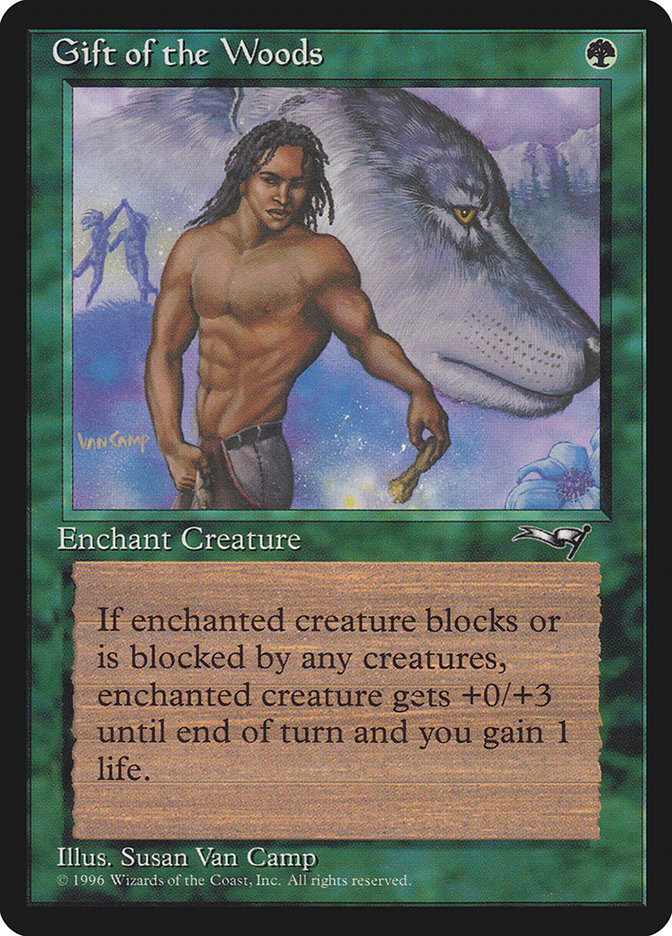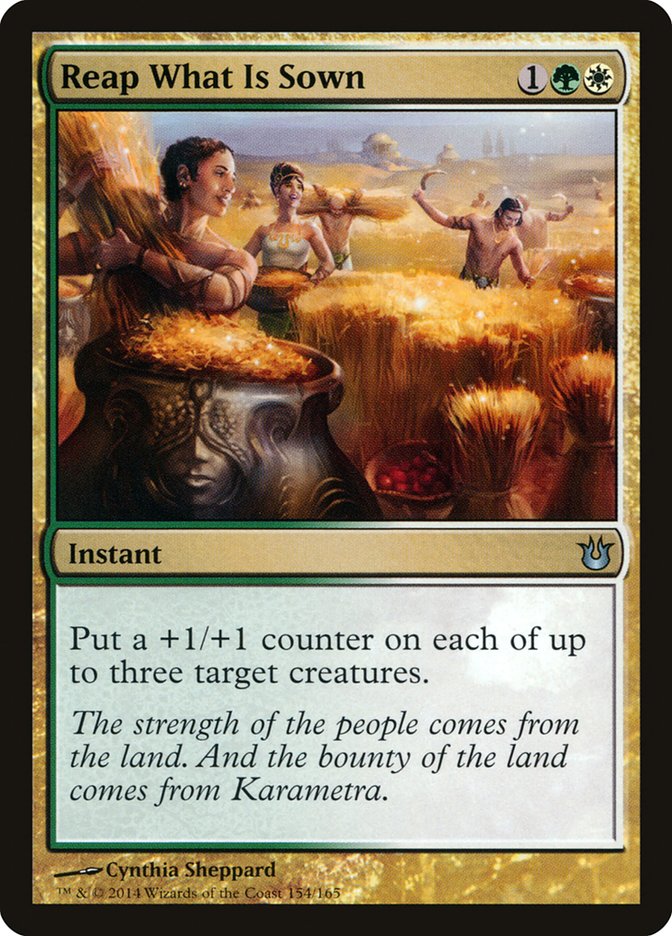Every once in a while I’ll take my ideas that don’t quite stretch out to full-article length and pack them into a “box” like so many cupcakes. The last
couple of times I’ve done it, in “Nooks and Crannies” and ” This Is Your Brain on Me,” have seen a pretty good reception and
it’s been a year since my last try, so it’s time for another series of observations and mini-articles — tidbits, if you will.
The Genius Behind the Name “Kiran Nalaar”
I’m happy that Kaladesh, despiteinitially seeming like “The Whitest Plane U’ Know” from the images selected for Chandra’s origin story ” Fire Logic,” turned out instead to be a
memorably diverse world befitting its linguistic origins in India, one of the great crossroads of the world. And nothing showed that diversity as memorably
as Chandra’s parents, Pia and Kiran Nalaar.
The
sad little girl lost in the crowd
on Guardian Automaton comes close, though.
The creative decisions that went into Chandra Nalaar for Lorwyn, made well before much of the current Wizards of the Coast Creative team ever
joined the company, made shaping her origin difficult. (It’s worth noting that parts of her ” original” story, particularly having siblings and hating her mother, were
jettisoned.) But as Doug Beyer noted, “Chandra has been repeatedly illustrated as a light-skinned person with red hair, and we didn’t try to change that
about her when showing her childhood.”
Once Doug and the Creative crew made that decision (and I think it was the right one), they then had the task of creating a world where Chandra and the
authorities’ fear of her both made sense. “India plus Steampunk” is one of no more than a handful of possible good answers, and a lot of the details, such
as the filigree and the fashions, fit well with that idea of Chandra.
No details are as pitch-perfect, though, as the names of Chandra’s parents, Pia and Kiran. “Pia” as a woman’s name has a global reach. “Kiran” is not so well-known in the West, but
it’s a name derived from Sanskrit (Wikipedia says it means “ray” like a ray of light) borne proudly by
both men and women.
Now, there are a couple of sly nods in Kiran’s name. In Chandra’s origin short story, when the soldiers come for Chandra in the woodland village, Kiran
uses a literal “light bomb” to disable them during his and Chandra’s escape attempt. Pretty clever.
Also clever? How, again according to Wikipedia, “Kiran” sounds remarkably like the Gaelic male name “Ciaran.” And what are the two places most associated with theGaelic languages? Ireland and Scotland, also famous for the sizable redheaded proportion of their populations.
If all this was planned in association with Kiran’s name — and the breadcrumb trail is extensive enough that I don’t think the choices were coincidence —
it’s one of the most brilliant strokes Wizards Creative has had in years.
What’re You Looking At?
The smallest details can make or break a representative painting. Take Viktor Vasnetsov’s Moving House, a
painting most familiar to anyone who plays Civilization V nearly as much as I
do. Now really focus on the eyes and who is looking where. The woman holding the rags looks straight ahead in a thousand-yard stare. The man, by contrast, looks right back at the viewer with what I
imagine to be contempt or the late 19th century Russian equivalent of “What’re you looking at?”
Then, of course, there is the little dog in the bottom right. It’s looking at the couple, alert and expectant. Whereas the humans have been beaten down by
life, the dog is more vital than either of them, adding levity to what would otherwise be a too-serious painting.
I’ve imagined for years that in a few seconds the dog would find itself punted into the sea by the
Russian dude, but I have weird thoughts sometimes.
Sometimes a little change in perspective makes all the difference. In
one of the most in-depth and surprisingly handy “Art in Focus” blog posts
on Original Magic Art, Winona Nelson explained her thought process behind Magic 2015‘s iconic hunk,
Enthralling Victor.
It’s worth a read in full, from the opening comment “This card was always intended to be total beefcake” to Winona’s virtual reference board and the
metaphorical balance beam she walked without falling off either side into “too sexual” or “too slapstick.” One key component, though oddly enough she
doesn’t call it out specifically, is in the eyes.
Go back to the Art in Focus post and look at the grayscale
digital sketch, the barbarian in particular. Notice how he’s looking right back at you? This is where eye contact comes into play. Think back to Moving House and how the man looks at the
viewer while the woman does not. The woman just “is” — she’s been painted as something to look at, as much of an object as the rags she holds, regardless
of who she was in life — whereas the man acknowledges the viewer, and one must assume the painter as well, and returns the stare with a side of attitude.
The Russian man, though, is just an old dude with a cane; a threat to the dog, perhaps, but not to the viewer. Enthralling Victor, on the other hand, is
wielding a giant axe and souped-up sexiness.
And he’s staring straight at you, while the awestruck Goblin is staring straight at him.
Now, this pattern and others can work in art (in my high school art history classes, Dr. Antonelli taught me about “gaze” via Mary Cassatt’sIn the Loge , which shows a woman spying and being spied upon through opera glasses), but for this illustration, having the Enthralling Victor look at the
viewer wasn’t the right call. The “caught you looking” challenge in his eyes makes him too aware of his own studly starpower.
And yes, I realize that if I wrote the exact same thing about a barbarian woman and not a man, it’d be a classic case of male gaze in action. In fact, it’s sketch-Enthralling Victor’s male gaze, right back at the viewer,
that amps up the squick factor.
The final painting, though, changes up the formula. Whatever Enthralling Victor is gazing at, it’s out of view and thus not part of the viewer’s concern.
He’s still a big buff barbarian dude, but he’s also not a big buff barbarian dude looking your way. With the Enthralling Victor thus dialed back down to
object status, the awestruck Goblin at the bottom right is back in balance, simultaneously a humorous thing to be looked at and a viewer surrogate in his
own way.
From the start Magic has had its uncomfortably large share of women-as-objects. (Exhibit A: the infamous Earthbind by Quentin Hoover.) Over the last
several years, though, there’s been a conscious move toward equal-opportunity eye candy, with newer artists such as Winona Nelson and Cynthia Sheppard
building on the work of Magic art pioneers like Terese Nielsen and Susan Van Camp.
A Quick Note on Uncharted Realms
Three weeks ago, Uncharted Realms halted the Battle for Zendikar story on both a point of resolution ( here’s the story, and the name’s a spoiler) and
a heck of a cliffhanger. For the past two weeks, readers have enjoyed standalone tales themed around Commander 2015 from two authors (Michael
Yichao and Alison Luhrs) who are both trained playwrights with day jobs at Wizards that don’t ordinarily pull them into Creative’s orbit.
The two stories are quite different, yet with their own enjoyable qualities. “All the Cairns of Jund” is an origin story of aCommander 2015 legend, told with verve. ” Family Values,” by contrast, is a continuation of a
previous story set on Ravnica, though it’s perfectly enjoyable on its own, with the Commander 2015 preview as antagonist rather than protagonist.
Both stories show how characters may reflect the color pie without becoming avatars or living embodiments of their segments.
I won’t go on too much about the stories — better for you to enjoy them on your own for now, without my commentary — but I will say this: “All the Cairns
of Jund,” “Family Values,” and the Battle for Zendikar Story‘s Episode 5, ” Memory of Blood,” set a new standard for Uncharted
Realms, and I’d love to see future tales meet and exceed it.
Great job, Michael and Alison!





